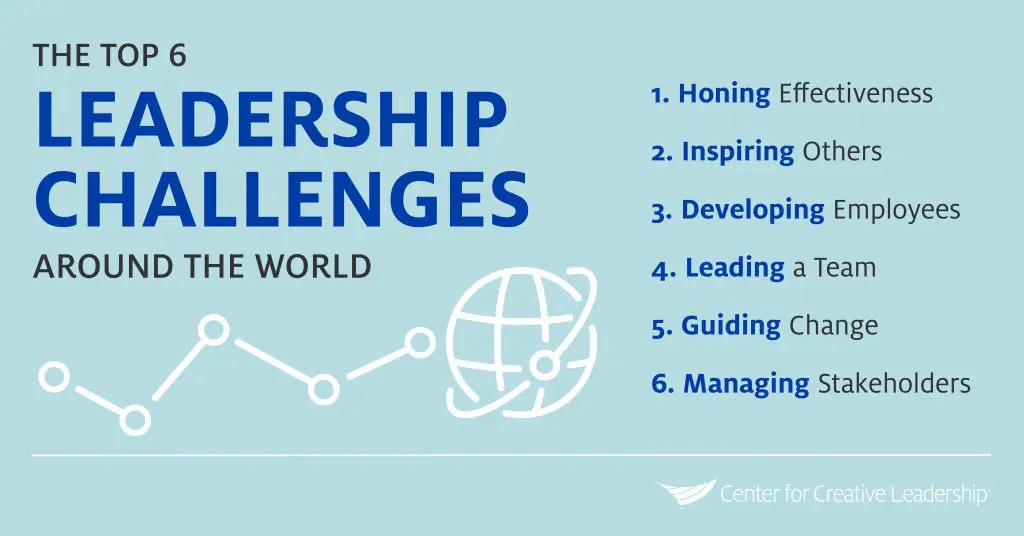What’s most challenging about leading organizations today? And do these leadership challenges differ around the world?
Our researchers conducted a study on this, going straight to the source to answer these questions about the top leadership challenges. The study gathered input from 763 middle- and executive-level leaders in organizations from China/Hong Kong, Egypt, India, Singapore, the United Kingdom, Spain, and the United States.
We found that leaders around the globe consistently face the same top 6 challenges — even if they describe their leadership challenges and the specific context in different ways.
It may be surprising to find so much consistency in these challenges, given that leaders came from all corners of the globe, as well as different industries, organizations, and work environments. Yet it seems that, overall, these 6 leadership challenges are inherent for leaders in the role of middle or senior manager, regardless of the context.
Thus, these 6 top challenges should be core focus areas for managerial development, everywhere in the world, and in all organizations.
So what are the most common leadership challenges around the world?
The 6 Most Common Challenges That Leaders Face
Around the World, More Similar Than Different
Regardless of their location, industry, or organizational culture, leaders universally face both internal and external challenges. These challenges may impact their careers, as well as their day-to-day experiences.
As noted in our white paper, we found these are the 6 most common challenges leaders face, regardless of where they are located.
1. Honing Effectiveness.
This leadership challenge is about developing the relevant skills — such as time management, prioritization, strategic thinking, decision-making, and getting up to speed with the job — to be more effective at work.
2. Inspiring Others.
This is the challenge of inspiring or motivating team members to ensure they’re satisfied with their jobs and working smarter.
3. Developing Employees.
This is the challenge of developing others, including coaching and mentoring effectively.
4. Leading a Team.
Another key challenge is that of team-building, team development, and team management. Specific leadership challenges related to this include how to instill pride, how to provide support, how to effectively engage in collaboration, how to lead a big team, how to establish team norms, and what to do when taking over a new team.
5. Guiding Change.
The challenge of managing, mobilizing, understanding, and leading change means that being a successful change leader isn’t easy. It requires knowing how to mitigate consequences, overcome resistance to change, and deal with team members’ reactions to change.
6. Managing Stakeholders.
The last leadership challenge is managing relationships, politics, and image in the work environment. This includes gaining managerial support, managing up, influencing others, and getting buy-in from other departments, groups, or individuals.
When Do the Top Leadership Challenges Most Commonly Emerge?
The “when” factor is another important consideration when identifying the leadership challenges that impact leaders around the world. But, what does that mean? Teams, organizations, and leaders may experience an increase in challenges during specific times, such as when:
- Something new is about to start, like a new project, employee, client, line of business, shift to a hybrid workforce, etc.
- Something is winding down and almost over, such as a project, role, contract, engagement, etc.
- Something changes dramatically, like a team member suddenly leaves, a financial issue affects the department, or business priorities change while the organization is navigating a crisis such as the global COVID-19 pandemic or conflict in Eastern Europe.
Any of these hurdles represent significant challenges for any leader. So, it’s vital to recognize when you or your organization are experiencing a difficult time, identify the specific internal and external roadblocks, and create a strategic plan to tackle the challenges.
How to Respond to These Top Leadership Challenges
5 Tips for Leaders
Here are 5 concrete things that leaders around the globe can work on to address these common leadership challenges:
1. Set goals for yourself and your team.
Be proactive in setting goals and establishing the timelines — and deadlines — necessary to keep yourself and your team members on track. The distractions you face can make it easy to lose sight of long-term and even short-term goals. You can easily get sucked into dealing with urgent issues that arise unexpectedly, rather than staying focused on producing the outcomes that matter most to your organization.
While no leader can completely avoid surprises, goal-setting provides a map you can return to time and again to refocus on your top priorities while handling other leadership challenges.
One time-honored approach is the SMART method. When setting a goal, make sure it’s:
- Specific. Write down a detailed description of what accomplishing the goal would involve.
- Measurable. Set targets that you can quantify to assess progress.
- Attainable. Stretch goals are fine, but you also need to make sure that achieving the goal is possible.
- Realistic. Be sure you understand what you will likely need — in terms of time, resources, and talent — to achieve it.
- Timed. Create deadlines for hitting milestones on the way to your goal, as well as for achieving the goal itself.
Just be sure to set goals that align with your values.
2. Delegate more to others.
You’ll be more productive in tackling leadership challenges, and you’ll empower your colleagues to take more ownership, if you delegate. Effective delegation requires more than just getting a task off your desk — it involves a repeating cycle of 4 key steps:
- Understanding your preferences. Effective delegators prioritize their workload and decide which tasks to keep and which to give to someone else. They also understand how much feedback they want while the person they’ve delegated to works on the task.
- Knowing your people. To delegate effectively, you must assign tasks to people with the necessary knowledge and skills. That means that you have to understand your people. Use delegation to help direct reports develop, allowing them to learn as they take on new tasks.
- Being clear about the purpose of the task. A task’s purpose gives it meaning. By aligning this purpose with team or individual beliefs and goals, delegation can become an opportunity for personal growth.
- Assessing and rewarding. You should engage in collaboration and work with your direct reports to develop ways to help them, and you, decide if a task has been completed properly, and to reward them appropriately.
You’ll build more trust on your team if you delegate more, as well.
3. Maximize your unique value.
There will always be more things competing for your attention than you have time and energy to do. Prioritize the most important tasks that only you can do, and delegate everything else to team members.
Leaders overcome leadership challenges and create value for their organizations by focusing on the unique contributions only they can make. Understanding what those unique values are for you, and delegating everything else (or as close to everything else as you can), allows you to maximize the value you create for the organization.
It’s important to recognize your own characteristics, behaviors, and habits in order to know what may be triggering challenges for you in your career. This way, you can work toward strengthening specific skills and growing as an individual leader. Some internal challenges that many leaders face include a lack of confidence, a fear of failure, maintaining authenticity during self-promotion, impatience, resistance in responding to new ideas, or overcoming impostor syndrome. All of these can be potential roadblocks to leadership success.
Understanding your own strengths and weaknesses and maximizing your unique value are part of increasing your self-awareness and understanding your personal leadership brand.
4. Get role clarity.
Understand what the core responsibilities are for your role, and what are secondary responsibilities, or even work that belongs to someone else.
That won’t stop people from asking you to take on additional tasks and projects. And there are certainly times when taking on additional duties may be required due to unusual circumstances, or might be important for your own professional development. But the most effective managers understand that they will largely be judged based on how effective they are at their core responsibilities and how they can overcome leadership challenges.
This also means that there will be times when you’ll have to say no. That can feel uncomfortable in a work environment. Practicing saying no and finding ways to do so with tact and professionalism are important. Turning down work that’s not part of your role helps keep you focused, and communicating effectively is a critical skill for leaders.
In fact, many of these suggestions for responding to the top leadership challenges around the world are part of developing the core leadership skills you need in every role, at every stage of your career.
5. Strengthen team alignment and collaboration.
What’s preventing your team from being on the same page and collaborating effectively together? Maybe you’re not being open and honest with each other, or maybe you’re not carving out enough time to celebrate the small wins. Either way, strengthening your team’s alignment is vital to organizational success — it allows you, and your team, to make difficult decisions with confidence and stay calm and positive in a crisis.
During challenging times, building trust is crucial. In fact, it’s one of the 3 keys for better team-building and collaboration. Without trust, people operate out of fear, putting success in jeopardy. Additionally, operating on agreed-upon principles will help align your team. Examples of this include focusing on values like accountability, mutual respect, and integrity.
For effective and structured collaboration to take place, teams must follow a framework composed of these 3 parts:
- Structural level: understand structures, roles, and responsibilities of team members.
- Systemic level: assess systems, processes, and policies that are currently in place.
- Interactional level: evaluate communication among team members.
By following this framework, leaders in any organization will gain better role clarity and strengthen their team’s alignment — both of which are necessary when responding to top leadership challenges.
And leaders who sometimes feel overwhelmed by their work can take heart in the fact that they’re not alone. By focusing on these 5 key behaviors, you can beat back those feelings and provide more value to your organization as you take on the most pressing leadership challenges.
A Final Word for HR Leaders
Focus Development Efforts on Addressing These 6 Most Common Leadership Challenges
Developmental initiatives are more effective when they align with real challenges that participants are facing. For those who work in training and development, understanding these 6 common challenges that leaders face around the world can be the catalyst for creating developmental initiatives that truly address leaders’ real-world needs.
That’s why we often suggest that a majority of development program content be the same, no matter where the training is taking place, or who’s going through the training. At the same time, we also recognize that what’s accepted in one culture may be unacceptable or taboo in another, and some behaviors may be the norm in one country but different in another. So, it’s also essential to be aware of cultural nuances and make adjustments as needed.
But given that leaders around the globe face many of the same basic challenges, those designing training initiatives can safely align development efforts for colleagues around the world that tackle these 6 common areas: developing managerial effectiveness, inspiring others, developing employees, leading a team, guiding change, and managing internal stakeholders and politics.
Ready to Take the Next Step?
Build your team’s capacity for overcoming these common leadership challenges. Partner with us to craft customized leadership development that develops the critical leadership skills and competencies that are right for your organization’s unique context and culture.












